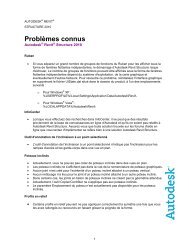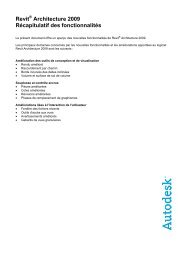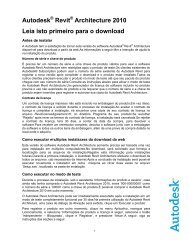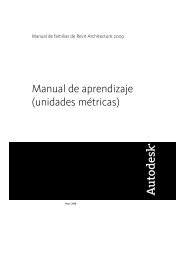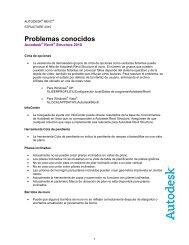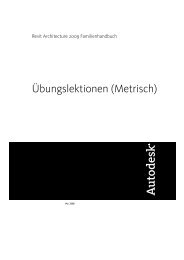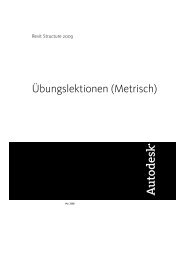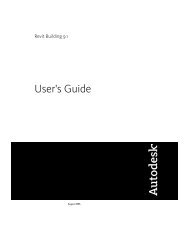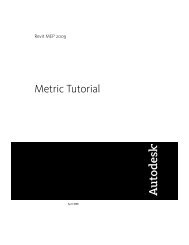- Page 1 and 2: Revit MEP 2009 Imperial Tutorial Ap
- Page 3: Portions relating to JPEG © Copyri
- Page 6 and 7: Placing Spaces . . . . . . . . . .
- Page 8 and 9: Adding Views to Sheets . . . . . .
- Page 10 and 11: Managing Linked Building Models . .
- Page 13 and 14: Introduction This introduction help
- Page 15 and 16: ■ For File name, enter the new fi
- Page 17 and 18: There are 2 types of model elements
- Page 19 and 20: ■ System families include walls,
- Page 21 and 22: The Options Bar The Type Selector t
- Page 23 and 24: The Design Bar is located on the le
- Page 25 and 26: The Status Bar ■ The browser is o
- Page 27 and 28: In addition, context-sensitive help
- Page 29 and 30: 9 If you use a mouse that has a whe
- Page 31 and 32: Some commands, such as Move and Cop
- Page 33: Express Workshop 23
- Page 37 and 38: In this tutorial, when you are inst
- Page 39 and 40: 13 Right-click the VAV box, and cli
- Page 41 and 42: Revit MEP automatically named the s
- Page 43 and 44: Revit MEP automatically creates and
- Page 45 and 46: Creating the Primary System Ductwor
- Page 47 and 48: 12 Press TAB until the point snap g
- Page 49 and 50: 24 Click on the center of the prima
- Page 51 and 52: 9 Click to select the air handler.
- Page 53 and 54: 20 Press ESC twice to end the comma
- Page 55 and 56: The System Browser is a tool that d
- Page 57 and 58: 13 On the Options Bar, click . 14 I
- Page 59 and 60: Adjust the zoom for the model 3 Typ
- Page 61 and 62: 12 On the Options Bar directly abov
- Page 63 and 64: 18 On the Options Bar, click (Filte
- Page 65 and 66: The circuit includes 4 lighting fix
- Page 67 and 68: Creating Switch Systems In this exe
- Page 69 and 70: 14 Move the cursor away from the sw
- Page 71 and 72: The bottom part of the tag displays
- Page 73 and 74: Turn off the tags 21 Press ESC to c
- Page 75 and 76: 5 In the drawing area near the crea
- Page 77 and 78: 16 While pressing CTRL, select the
- Page 79 and 80: Rewire a circuit 21 Press ESC to cl
- Page 81 and 82: The two circuits are automatically
- Page 83 and 84: 4 In the Project Browser, under Pan
- Page 85:
Developing Your MEP Designs 75
- Page 88 and 89:
■ In the left pane of the Open di
- Page 90 and 91:
The Level 1 Plenum floor plan is no
- Page 92 and 93:
23 Click Modify. Next, you rename t
- Page 94 and 95:
Place a space in the entrance area
- Page 96 and 97:
NOTE Space separation lines are MEP
- Page 98 and 99:
Creating Zones 61 If you want to sa
- Page 100 and 101:
8 Click the space to add it to the
- Page 102 and 103:
92 | Chapter 3 Mechanical Systems Y
- Page 104 and 105:
in the System Browser. In the next
- Page 106 and 107:
■ Verify that VAV - Single Duct i
- Page 108 and 109:
14 With Office 111 selected, click
- Page 110 and 111:
You may need to spin, pan, or zoom
- Page 112 and 113:
3 In the Element Properties dialog,
- Page 114 and 115:
Copies of the air terminal are plac
- Page 116 and 117:
26 On the Mechanical tab of the Des
- Page 118 and 119:
■ In the Element Properties dialo
- Page 120 and 121:
■ Use the button on the right to
- Page 122 and 123:
NOTE Do not modify the return or ex
- Page 124 and 125:
TIP Although this view does not con
- Page 126 and 127:
The Layout Path tab appears on the
- Page 128 and 129:
Size the duct The system components
- Page 130 and 131:
IMPORTANT Remember that all system
- Page 132 and 133:
On the Options Bar, the selected VA
- Page 134 and 135:
Add an endcap 124 | Chapter 4 Mecha
- Page 136 and 137:
The low pressure secondary air syst
- Page 138 and 139:
128 | Chapter 4 Mechanical Systems:
- Page 140 and 141:
130 | Chapter 4 Mechanical Systems:
- Page 142 and 143:
97 While pressing CTRL, and working
- Page 144 and 145:
This low pressure secondary air sys
- Page 146 and 147:
The completed level 2 secondary sup
- Page 148 and 149:
You many need to zoom out to view t
- Page 150 and 151:
140 | Chapter 4 Mechanical Systems:
- Page 152 and 153:
7 Draw duct as shown in the followi
- Page 154 and 155:
144 | Chapter 4 Mechanical Systems:
- Page 156 and 157:
You can press TAB 3 times to check
- Page 158 and 159:
The completed level 2 air system la
- Page 160 and 161:
Size the level 1 primary duct 8 Pla
- Page 162 and 163:
13 Using the process that you just
- Page 164 and 165:
Apply the color scheme 4 On the Mec
- Page 166 and 167:
18 If you want to save your work, c
- Page 168 and 169:
Size the system 10 Press Esc twice
- Page 170 and 171:
sizes. In the next exercise, you us
- Page 172 and 173:
10 Click to place the current inspe
- Page 174 and 175:
15 Move the cursor over the Men’s
- Page 176 and 177:
166 | Chapter 4 Mechanical Systems:
- Page 178 and 179:
Completing the Supply Air Systems I
- Page 180 and 181:
11 Click to specify the duct riser
- Page 182 and 183:
19 Zoom out the view to show the du
- Page 184 and 185:
174 | Chapter 4 Mechanical Systems:
- Page 186 and 187:
Check connectivity Add endcaps 176
- Page 188 and 189:
45 Place the cursor over the end of
- Page 190 and 191:
180 | Chapter 4 Mechanical Systems:
- Page 192 and 193:
70 On the System Inspector tab of t
- Page 194 and 195:
184 | Chapter 4 Mechanical Systems:
- Page 196 and 197:
that are associated with each warni
- Page 198 and 199:
188
- Page 200 and 201:
2 In the Project Browser, right-cli
- Page 202 and 203:
16 In the Filters dialog, under Fil
- Page 204 and 205:
All filtered components hide from v
- Page 206 and 207:
60 Click OK. The duct risers and AC
- Page 208 and 209:
You may need to move the Section 1
- Page 210 and 211:
20 In the drawing area, right-click
- Page 212 and 213:
TIP If you have trouble selecting t
- Page 214 and 215:
15 Right-click Hydronic Supply 1, a
- Page 216 and 217:
IMPORTANT If you select system comp
- Page 218 and 219:
Modify the level 2 supply pipe layo
- Page 220 and 221:
are automatically inserted. This pi
- Page 222 and 223:
Modify the pipe run TIP You can eas
- Page 224 and 225:
Check connectivity would not displa
- Page 226 and 227:
■ In the Layout Path tool, modify
- Page 228 and 229:
Resolve pipe interference with the
- Page 230 and 231:
The section head and tail display,
- Page 232 and 233:
18 Drag the pipe connector up to th
- Page 234 and 235:
27 Select the tee, right-click and
- Page 236 and 237:
The return pipe run is connected as
- Page 238 and 239:
Although this section was used for
- Page 240 and 241:
54 The level 2 supply and return pi
- Page 242 and 243:
8 Zoom in on the boiler. 9 On the P
- Page 244 and 245:
17 Draw the pipe segment straight u
- Page 246 and 247:
Next, you connect the boiler to the
- Page 248 and 249:
This creates a 1 foot pipe segment.
- Page 250 and 251:
Next, you connect the boiler to the
- Page 252 and 253:
The boiler is connected to the left
- Page 254 and 255:
55 Using the method that you learne
- Page 256 and 257:
NOTE Make certain to click the supp
- Page 258 and 259:
The aligned return pipes are as sho
- Page 260 and 261:
The selected pipe runs and mechanic
- Page 262 and 263:
Placing Circulator Pumps In this ex
- Page 264 and 265:
18 TIP If you need to reposition th
- Page 266 and 267:
28 Repeat this method to connect th
- Page 268 and 269:
The pump rotates 90 degrees to the
- Page 270 and 271:
Notice that the pumps moved from th
- Page 272 and 273:
11 Click to place the current inspe
- Page 274 and 275:
4 NOTE The check systems warnings c
- Page 276 and 277:
14 Right-click Hydronic Supply 1, a
- Page 278 and 279:
268
- Page 280 and 281:
The electrical settings determine t
- Page 282 and 283:
Voltage definitions can be deleted
- Page 284 and 285:
Load component families 11 NOTE The
- Page 286 and 287:
7 On the Options Bar, click (Proper
- Page 288 and 289:
19 Scroll up to the Electrical - Li
- Page 290 and 291:
according to space type. Consequent
- Page 292 and 293:
Dataset: ■ Click File menu ➤ Op
- Page 294 and 295:
20 Click File menu ➤ Close. NOTE
- Page 296 and 297:
12 Click Modify. 286 | Chapter 6 El
- Page 298 and 299:
Check the illumination levels again
- Page 300 and 301:
Level 2 290 | Chapter 6 Electrical
- Page 302 and 303:
12 Continue placing switches of thi
- Page 304 and 305:
18 In the open office area, place a
- Page 306 and 307:
Level 2 25 You can save the open fi
- Page 308 and 309:
1-Power 298 | Chapter 6 Electrical
- Page 310 and 311:
22 Click Modify. 300 | Chapter 6 El
- Page 312 and 313:
30 Using the same procedure, place
- Page 314 and 315:
7 You can save the open file if you
- Page 316 and 317:
12 Click Modify 13 Select the trans
- Page 318 and 319:
308 | Chapter 6 Electrical Systems
- Page 320 and 321:
■ Open Imperial ➤ Electrical
- Page 322 and 323:
312 | Chapter 6 Electrical Systems
- Page 324 and 325:
27 Using the same procedures, creat
- Page 326 and 327:
316 | Chapter 6 Electrical Systems
- Page 328 and 329:
318 | Chapter 6 Electrical Systems
- Page 330 and 331:
33 You can save the open file if yo
- Page 332 and 333:
7 Draw a pick box around the 6 ligh
- Page 334 and 335:
28 On the Fields tab of the Schedul
- Page 336 and 337:
326 | Chapter 6 Electrical Systems
- Page 338 and 339:
328 | Chapter 6 Electrical Systems
- Page 340 and 341:
Vertices let you route wires in you
- Page 342 and 343:
332 | Chapter 6 Electrical Systems
- Page 344 and 345:
The lighting fixtures and 3-way swi
- Page 346 and 347:
336 | Chapter 6 Electrical Systems
- Page 348 and 349:
This warning refers to the feed fro
- Page 350 and 351:
6 Select panel H-2, and on the Opti
- Page 352 and 353:
Now that you have set transformer T
- Page 354 and 355:
Planning Plumbing Systems Creating
- Page 356 and 357:
■ For Union, select Pipe Coupling
- Page 358 and 359:
Add a second toilet b On the Option
- Page 360 and 361:
Place sinks 350 | Chapter 7 Plumbin
- Page 362 and 363:
39 Click Modify. 40 You can save th
- Page 364 and 365:
354 | Chapter 7 Plumbing Systems 20
- Page 366 and 367:
Move the cursor to the left to the
- Page 368 and 369:
33 In the Project Browser, expand P
- Page 370 and 371:
4 Select the tee, right-click the c
- Page 372 and 373:
14 Click Modify. 362 | Chapter 7 Pl
- Page 374 and 375:
The double wye is added to the vert
- Page 376 and 377:
42 In the Project Browser, expand P
- Page 378 and 379:
Specify slope for the sink sanitary
- Page 380 and 381:
370 | Chapter 7 Plumbing Systems Wh
- Page 382 and 383:
4 Select the elbow, and press Delet
- Page 384 and 385:
374 | Chapter 7 Plumbing Systems 12
- Page 386 and 387:
25 You can save the open file if yo
- Page 388 and 389:
378 | Chapter 7 Plumbing Systems 14
- Page 390 and 391:
Add a cleanout Redefine fittings 38
- Page 392 and 393:
36 You can save the open file if yo
- Page 394 and 395:
In the Filters dialog, select Sanit
- Page 396 and 397:
21 Click Modify. The vent is automa
- Page 398 and 399:
Add a vent to the sinks 28 Click Vi
- Page 400 and 401:
40 Highlight any component in the s
- Page 402 and 403:
The Domestic Cold Water folder is a
- Page 404 and 405:
45 Click Modify. 394 | Chapter 7 Pl
- Page 406 and 407:
All of the cold water piping is in
- Page 408 and 409:
64 On the Options Bar, specify 3/4"
- Page 410 and 411:
400 | Chapter 7 Plumbing Systems 18
- Page 412 and 413:
34 Select the middle sink in the vi
- Page 414 and 415:
404
- Page 416 and 417:
Starting the Fire Protection Projec
- Page 418 and 419:
24 Select a field, and use the Move
- Page 420 and 421:
Placing Sprinklers In this exercise
- Page 422 and 423:
12 Move the cursor diagonally to th
- Page 424 and 425:
18 Move the cursor down and to the
- Page 426 and 427:
The sprinklers are placed. 416 | Ch
- Page 428 and 429:
418 | Chapter 8 Fire Protection Sys
- Page 430 and 431:
Next, you place sprinklers in Offic
- Page 432 and 433:
422 | Chapter 8 Fire Protection Sys
- Page 434 and 435:
38 Move the cursor to the right int
- Page 436 and 437:
IMPORTANT When specifying array sta
- Page 438 and 439:
Next, you place a sprinkler in the
- Page 440 and 441:
68 Using the same method, center th
- Page 442 and 443:
74 Click File menu ➤ Close. NOTE
- Page 444 and 445:
The Fire Protection Wet system is c
- Page 446 and 447:
Modify the layout Next, you modify
- Page 448 and 449:
29 Drag the parallel movement contr
- Page 450 and 451:
38 Select the horizontal branch aga
- Page 452 and 453:
48 Zoom in on the 3 offices at the
- Page 454 and 455:
■ Select the sprinkler to the lef
- Page 456 and 457:
446 | Chapter 8 Fire Protection Sys
- Page 458 and 459:
The selected sprinklers display in
- Page 460 and 461:
18 Scroll to the right and select t
- Page 462 and 463:
Dataset ■ Click File menu ➤ Ope
- Page 464 and 465:
Create the dry system Next, you cha
- Page 466 and 467:
23 Press ESC to exit the Draw tool.
- Page 468 and 469:
Check connectivity and validate pip
- Page 470 and 471:
460 | Chapter 8 Fire Protection Sys
- Page 472 and 473:
14 With the main selected, while pr
- Page 474 and 475:
21 Click in the 2 - Fire Prot view
- Page 476 and 477:
Tag the pipes 30 Select the segment
- Page 478 and 479:
42 This completes the Fire Protecti
- Page 480 and 481:
mechanical, electrical, or plumbing
- Page 482 and 483:
25 In the Shared Parameters dialog,
- Page 484 and 485:
Map Parameter Values to Connector F
- Page 486 and 487:
13 Using the same method, create th
- Page 488 and 489:
32 On the Design Bar, click Electri
- Page 490 and 491:
■ For Electric Heat Power, enter
- Page 492 and 493:
72 Click Window menu ➤ System Bro
- Page 494 and 495:
8 Click File menu ➤ Close. Modify
- Page 496 and 497:
Create a system ■ Place a Single
- Page 498 and 499:
Modifying a Water Closet This exerc
- Page 500 and 501:
11 In the Element Properties dialog
- Page 502 and 503:
3 On the Options Bar, click Edit Fa
- Page 504 and 505:
1 In the Project Browser, expand Vi
- Page 506 and 507:
10 Click Modify. Notice that the bo
- Page 508 and 509:
Creating Families 20 Click File men
- Page 510 and 511:
TIP You may want set the scale to 6
- Page 512 and 513:
20 On the Design Bar, click Lines.
- Page 514 and 515:
27 Save the family. Define family a
- Page 516 and 517:
36 Highlight the face at the top of
- Page 518 and 519:
text_file_lookup function that can
- Page 520 and 521:
24 Click Modify 25 Select the left
- Page 522 and 523:
NOTE Piping objects generally show
- Page 524 and 525:
74 Click OK. 75 Click Extrusion Pro
- Page 526 and 527:
106 Click to add the connector. 107
- Page 528 and 529:
113 Click Modify. 114 Select the co
- Page 530 and 531:
Pinning prevents accidentally movin
- Page 532 and 533:
30 In the drawing area, draw a hori
- Page 534 and 535:
NOTE Temporary dimensions have two
- Page 536 and 537:
62 Click File menu ➤ Save to save
- Page 538 and 539:
Generic Elbow.csv lookup table file
- Page 540 and 541:
99 On the Design Bar, click Family
- Page 542 and 543:
119 On the Options Bar, click (Filt
- Page 544 and 545:
The geometry for the fitting body i
- Page 546 and 547:
Only the reference planes and refer
- Page 548 and 549:
158 Relocate the dimension annotati
- Page 550 and 551:
NOTE If the part does not flex and
- Page 552 and 553:
Again, length is approximate. The 2
- Page 554 and 555:
Flex the part 199 On the View Contr
- Page 556 and 557:
209 In the drawing area, cross-pick
- Page 558 and 559:
225 Click Modify. Next, you link bo
- Page 560 and 561:
NOTE Do not use the flip arrows to
- Page 562 and 563:
it is associated with the mechanica
- Page 564 and 565:
IMPORTANT Shape handles are not use
- Page 566 and 567:
TIP You can also mirror the opposit
- Page 568 and 569:
An arced line is drawn. 21 With the
- Page 570 and 571:
■ For Offset, verify that 0' 0" i
- Page 572 and 573:
■ Pipe connectors are used for pi
- Page 574 and 575:
Loss Coefficient Flow Configuration
- Page 576 and 577:
Primary Connector Link Connector In
- Page 578 and 579:
Hosts Templates Lookup Tables NOTE
- Page 580 and 581:
Category Revit MEP components fall
- Page 582 and 583:
Family Categories Communication Dev
- Page 584 and 585:
574
- Page 586 and 587:
576
- Page 588 and 589:
Level 1 Furniture Plan created from
- Page 590 and 591:
Duplicate a view and change the sca
- Page 592 and 593:
16 Right-click, and click Hide in v
- Page 594 and 595:
Modify the elevation extents 6 On t
- Page 596 and 597:
Modify the section line 17 Click th
- Page 598 and 599:
21 On the Design Bar, click Modify.
- Page 600 and 601:
Resulting callout view - Enlarged S
- Page 602 and 603:
■ Select the middle grip, and dra
- Page 604 and 605:
16 Modify the callout leader as sho
- Page 606 and 607:
Modified stair callout head and bou
- Page 608 and 609:
30 On the Design Bar, click Load in
- Page 610 and 611:
Set a crop region for the view 1 In
- Page 612 and 613:
17 In the Project Browser, right-cl
- Page 614 and 615:
6 In the Project Browser, select Ro
- Page 616 and 617:
ating of the walls. After you apply
- Page 618 and 619:
Masking regions sketched over the u
- Page 620 and 621:
14 On the Design Bar, click Finish
- Page 622 and 623:
Set the visibility and graphics of
- Page 624 and 625:
Modify visibility and graphics by e
- Page 626 and 627:
Training File ■ Click File menu
- Page 628 and 629:
Display additional project informat
- Page 630 and 631:
Drag the Level 1 floor plan onto a
- Page 632 and 633:
Change the scale of the detail view
- Page 634 and 635:
Training File ■ Continue to use t
- Page 636 and 637:
8 Click File menu ➤ Save. Creatin
- Page 638 and 639:
13 In the Project Browser, under Sh
- Page 640 and 641:
630
- Page 642 and 643:
632 | Chapter 11 Tagging and Schedu
- Page 644 and 645:
10 In the left pane of the Load Fam
- Page 646 and 647:
Hide the room separations 24 Click
- Page 648 and 649:
■ Closet door in living room 5 On
- Page 650 and 651:
Tag Level 2 doors 12 In the Project
- Page 652 and 653:
8 Select the furniture in the livin
- Page 654 and 655:
20 On the Options Bar, click (Filte
- Page 656 and 657:
■ In the left pane of the Open di
- Page 658 and 659:
15 In the Element Properties dialog
- Page 660 and 661:
3 In the Project Parameters dialog,
- Page 662 and 663:
■ For Phase, verify that New Cons
- Page 664 and 665:
20 Save the file. Creating a Room S
- Page 666 and 667:
13 Save the file. Scheduling Rooms
- Page 668 and 669:
Placed rooms are indicated with a c
- Page 670 and 671:
21 On the Options Bar, click (Eleme
- Page 672 and 673:
46 Open the Room Schedule. Notice t
- Page 674 and 675:
22 In the Color dialog, under Custo
- Page 676 and 677:
40 Draw a selection box around the
- Page 678 and 679:
55 Click . 56 In the Element Proper
- Page 680 and 681:
73 Save the file. Creating a Materi
- Page 682 and 683:
11 On the Formatting tab: ■ Under
- Page 684 and 685:
Training File ■ Click File menu
- Page 686 and 687:
Create a tag using shared parameter
- Page 688 and 689:
Placing,Tagging, and Scheduling a F
- Page 690 and 691:
19 Move the cursor up through the d
- Page 692 and 693:
34 On the Fields tab of the Schedul
- Page 694 and 695:
11 Close the exercise file. Exporti
- Page 696 and 697:
686
- Page 698 and 699:
Shared levels report elevation rela
- Page 700 and 701:
By selecting the Level 1 line, you
- Page 702 and 703:
Dimensioning ■ In the Type Select
- Page 704 and 705:
4 Move the cursor over the curtain
- Page 706 and 707:
11 Using the same method, select th
- Page 708 and 709:
29 Select the dimension string, and
- Page 710 and 711:
42 Select the radial dimension. 43
- Page 712 and 713:
52 Move the cursor to the left to r
- Page 714 and 715:
Controlling Witness Lines 7 On the
- Page 716 and 717:
7 Using the same method, select the
- Page 718 and 719:
15 Moving the cursor to the right,
- Page 720 and 721:
Angular and linear dimensions with
- Page 722 and 723:
11 Using the same method, select th
- Page 724 and 725:
5 In the text box, type EXISTING BU
- Page 726 and 727:
19 Select the blue grip at the end
- Page 728 and 729:
32 If you want to save your changes
- Page 730 and 731:
Detailing the View In this exercise
- Page 732 and 733:
19 On the Design Bar, click Modify.
- Page 734 and 735:
Add wallboard detail component 724
- Page 736 and 737:
■ Click Modify. Add lumber compon
- Page 738 and 739:
Draw detail lines 728 | Chapter 13
- Page 740 and 741:
Add a vapor barrier 730 | Chapter 1
- Page 742 and 743:
7 Click Modify. Creating Detail Com
- Page 744 and 745:
17 Click File menu ➤ Save As. 18
- Page 746 and 747:
6 Click Modify. Assign keynote para
- Page 748 and 749:
23 In the left pane of the Load Fam
- Page 750 and 751:
Add keynotes 58 Using the method us
- Page 752 and 753:
■ Change the keynote style back t
- Page 754 and 755:
Modify detail view properties 7 In
- Page 756 and 757:
5 In the Type Selector, select Nomi
- Page 758 and 759:
25 Click Modify. Add wood filled re
- Page 760 and 761:
46 On the Tools toolbar, click (Ali
- Page 762 and 763:
61 Click Modify. 62 Select the left
- Page 764 and 765:
754 | Chapter 13 Detailing 82 Selec
- Page 766 and 767:
94 Select the mirrored line on the
- Page 768 and 769:
115 In the Type Selector, select Li
- Page 770 and 771:
Add text notes to complete the deta
- Page 772 and 773:
2 On the Drafting tab of the Design
- Page 774 and 775:
14 With the copy selected, on the O
- Page 776 and 777:
Tag H Text Saw cut existing brick w
- Page 778 and 779:
2 Click View menu ➤ New ➤ Drawi
- Page 780 and 781:
Continue to use the training file y
- Page 782 and 783:
17 In the Type Selector, select Vie
- Page 784 and 785:
Add titles to the legend components
- Page 786 and 787:
Place the legend on a sheet 776 | C
- Page 788 and 789:
32 In the floor plan view, zoom to
- Page 790 and 791:
2 Click Settings menu ➤ Revisions
- Page 792 and 793:
Add a revision cloud 782 | Chapter
- Page 794 and 795:
Continue to use the training file y
- Page 796 and 797:
Change revision scheme from numeric
- Page 798 and 799:
27 On the Options Bar, click Edit F
- Page 800 and 801:
Load revised schedule into the proj
- Page 802 and 803:
Copy the text 5 Open the Training F
- Page 804 and 805:
794
- Page 806 and 807:
Dependent view of lab building Depe
- Page 808 and 809:
Create dependent views 1 In the Pro
- Page 810 and 811:
10 Click in the drawing area, and o
- Page 812 and 813:
■ Move the cursor down and click
- Page 814 and 815:
35 On the Design Bar, click Modify.
- Page 816 and 817:
46 In the Project Browser, under Fl
- Page 818 and 819:
57 On the Zoom flyout, click Zoom T
- Page 820 and 821:
13 On the View Control Bar, click (
- Page 822 and 823:
30 On the Design Bar, click Modify.
- Page 824 and 825:
814
- Page 826 and 827:
Training File ■ Click File menu
- Page 828 and 829:
Change the origin point for the gro
- Page 830 and 831:
820 | Chapter 16 Grouping 14 On the
- Page 832 and 833:
822 | Chapter 16 Grouping NOTE If t
- Page 834 and 835:
824 | Chapter 16 Grouping 3 Click (
- Page 836 and 837:
16 On the Design Bar, click Modify.
- Page 838 and 839:
Training File Continue using the tr
- Page 840 and 841:
10 Click File menu ➤ Save. Workin
- Page 842 and 843:
Add a text note 8 On the Drafting t
- Page 844 and 845:
manner that a drawing component can
- Page 846 and 847:
13 Select the model group 2 Bedroom
- Page 848 and 849:
Convert group instance to a linked
- Page 850 and 851:
Increasing performance using select
- Page 852 and 853:
Step 4: Subdivide the building mode
- Page 854 and 855:
In the next exercise, you enable Wo
- Page 856 and 857:
17 On the Options Bar, click . 18 I
- Page 858 and 859:
Working Individually with Worksets
- Page 860 and 861:
Modify the building model 25 Select
- Page 862 and 863:
Although this exercise is designed
- Page 864 and 865:
A message displays warning you that
- Page 866 and 867:
If you intend to complete the final
- Page 868 and 869:
Checking out worksets Both User 1 a
- Page 870 and 871:
860
- Page 872 and 873:
In this particular case, the task i
- Page 874 and 875:
TIP You can zoom in and out easily
- Page 876 and 877:
25 On the Edit toolbar, click . 26
- Page 878 and 879:
47 Under Roofing, select Option 2.
- Page 880 and 881:
60 After aligning the beam, click t
- Page 882 and 883:
In this exercise, you set up multip
- Page 884 and 885:
18 Move the cursor horizontally to
- Page 886 and 887:
Zoom out to see that the 34 louvers
- Page 888 and 889:
44 In the Element Properties dialog
- Page 890 and 891:
13 Specify Beam for the Structure d
- Page 892 and 893:
The beam and louver systems are now
- Page 894 and 895:
Phasing Your Model In this exercise
- Page 896 and 897:
You should now have a separate floo
- Page 898 and 899:
44 Click View menu ➤ View Propert
- Page 900 and 901:
Notice that all the elements are di
- Page 902 and 903:
15 Using the following illustration
- Page 904 and 905:
Linking Building Models In this les
- Page 906 and 907:
■ Click Open. 10 In the Project B
- Page 908 and 909:
18 On the View menu, click Zoom ➤
- Page 910 and 911:
Move the townhouse The rotated town
- Page 912 and 913:
A copy of the townhouse displays on
- Page 914 and 915:
Notice that the townhouse is not at
- Page 916 and 917:
NOTE If you intend to complete the
- Page 918 and 919:
Modify display settings of linked f
- Page 920 and 921:
TIP In the Manage Links dialog, you
- Page 922 and 923:
When you are working in the host pr
- Page 924 and 925:
3 In the Element Properties dialog,
- Page 926 and 927:
Notice the site topography and the
- Page 928 and 929:
NOTE If you intend to complete the
- Page 930 and 931:
2 On the View tab of the Design Bar
- Page 932 and 933:
922
- Page 934 and 935:
924
- Page 936 and 937:
10 In the Options dialog, click the
- Page 938 and 939:
names and path, and you can create
- Page 940 and 941:
Modifying Snap Settings 11 In the O
- Page 942 and 943:
This is the increment that you adde
- Page 944 and 945:
Notice the materials listed on the
- Page 946 and 947:
Notice that the exterior walls are
- Page 948 and 949:
Notice that no model surface patter
- Page 950 and 951:
2 On the keyboard, use the shortcut
- Page 952 and 953:
26 Select Paint Dark Red Glossy, an
- Page 954 and 955:
13 In the Project Browser, under 3D
- Page 956 and 957:
■ Click (Line). 35 Draw lines for
- Page 958 and 959:
Notice that the windows on the west
- Page 960 and 961:
When you create a new view and spec
- Page 962 and 963:
Create a new browser organization n
- Page 964 and 965:
13 Select the default template. TIP
- Page 966 and 967:
The dialog has 3 tabs: ■ The Mode
- Page 968 and 969:
Modify project browser organization
- Page 970 and 971:
7 Press ESC twice to return to the
- Page 972 and 973:
Create and modify view templates 1
- Page 974 and 975:
35 If you want to add schedules to
- Page 976 and 977:
on page 649. If you do not need to
- Page 978:
10 Repeat these steps as needed. TI



